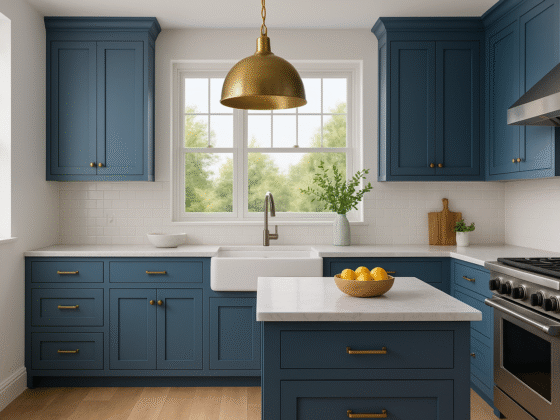Table of Contents Show
How Cultural Diversity Shapes Modern European Interior Design
Europe has always been a mosaic of cultures, where art, architecture, and craftsmanship evolve through centuries of exchange. In today’s design world, that cultural blend has become more intentional than ever. Homes across the continent now serve as living reflections of identity — merging tradition with innovation, and heritage with modern needs.
From Scandinavian simplicity to Mediterranean warmth, and now to a growing wave of global fusion, European interiors are no longer defined by region alone. Instead, they represent the people who inhabit them — individuals shaped by multiple roots, influences, and experiences.
This new era of European design isn’t just about aesthetics; it’s about connection and expression. Every material, color, and texture tells a story — one that celebrates diversity, inclusivity, and the timeless beauty of cultural harmony.
The Foundations — Classic European Design and Its Core Values
Before exploring the modern fusions shaping today’s European interiors, it’s important to understand the foundations — the timeless values that continue to define Europe’s design philosophy. Rooted in history, craftsmanship, and balance, classic European design has always celebrated both beauty and purpose.
The Pillars of European Design: Balance, Heritage, and Functionality
European design has never been about excess — it’s about balance. Whether in the elegant symmetry of French neoclassicism, the warmth of Italian craftsmanship, the minimalist lines of Nordic interiors, or the refined comfort of British homes, every style reflects a deep respect for harmony and function.
Each region carries its own story:
- France blends grandeur with artistic restraint, emphasizing proportion and detail.
- Italy celebrates emotion and craftsmanship, turning furniture and lighting into art.
- The Nordics champion simplicity and light, where form follows purpose.
- Britain combines tradition with coziness, creating spaces that feel both elegant and lived-in.
Despite their differences, these traditions share one constant principle — design must serve life. That’s why European homes feel both timeless and practical, filled with subtle details that merge comfort, culture, and authenticity.
Light, Space, and Materiality: The Essence of European Aesthetics
If design is Europe’s language, then light and materials are its dialects.
In the north, where daylight is scarce, interiors embrace brightness — pale woods, white walls, and soft fabrics reflect every bit of sunlight, creating warmth against long winters.
In the south, the story changes. Mediterranean homes lean into shadows and texture — terracotta floors, cool stone walls, and thick fabrics filter the sunlight into golden hues. These contrasts aren’t stylistic choices; they are cultural responses shaped by geography and climate.
Natural materials — wood, stone, clay, linen, and wool — have always carried symbolic value across Europe. They represent authenticity and connection to the land, ensuring that even the most luxurious spaces remain grounded in nature and tradition.
The Global Shift — Why Traditional Styles Are Evolving
As the world becomes increasingly connected, the lines that once defined national styles in interior design have begun to blur. In Europe, this transformation has created both opportunity and challenge — a new era where tradition meets globalization, and individuality struggles to stand out in a sea of mass production.
The Threat of Homogenization
Over the last two decades, the rise of mass-produced furniture and global retail chains — the so-called “IKEA effect” — has changed how people decorate their homes. While these brands made design accessible, they also introduced a certain uniformity that transcended borders.
Walk into apartments in Paris, Berlin, or Copenhagen, and you might find the same minimal sofa, the same framed prints, the same Scandinavian coffee table. What once reflected regional craftsmanship and cultural stories has slowly turned into a shared, predictable aesthetic.
This homogenization has created a quiet tension in European design: the battle between comfort and identity.
People love the simplicity and affordability of global design, but many are beginning to ask — “Where is the soul?”
Designers across Europe are now pushing back, looking for ways to reclaim authenticity without losing the convenience of modern living. This resistance has sparked a powerful counter-movement — one rooted in local culture yet open to global influence.
The Rise of Glocalism in Design
Out of this tension emerged a new philosophy: Glocalism — the blending of global ideas with local character.
Rather than rejecting globalization, European designers have begun to reinterpret it, infusing modern interiors with heritage, craft, and a renewed sense of place.
Across the continent, you’ll find homes that mix Swedish minimalism with Mediterranean color, or Dutch practicality with Moroccan texture. These combinations aren’t accidental — they represent a cultural awakening, a desire to create spaces that feel personal, rooted, and globally aware.
Designers now speak of “belonging through design” — crafting spaces that honor where you come from, yet reflect the diverse world you live in. This is the essence of the new European aesthetic: modern, multicultural, and unmistakably human.
The New Cultural Hybrids — Europe’s Emerging Fusion Styles
Across today’s European homes, a quiet revolution is unfolding — one that goes beyond trends or colors.
It’s a movement of fusion and identity, where cultures intertwine to create designs that feel both familiar and refreshingly new.
These are not random mixes, but carefully crafted styles that celebrate heritage while embracing innovation.
Here are some of the most inspiring cultural hybrids shaping the future of European interior design.
Nordic-Balkan Hybrid — Minimalism with Soul
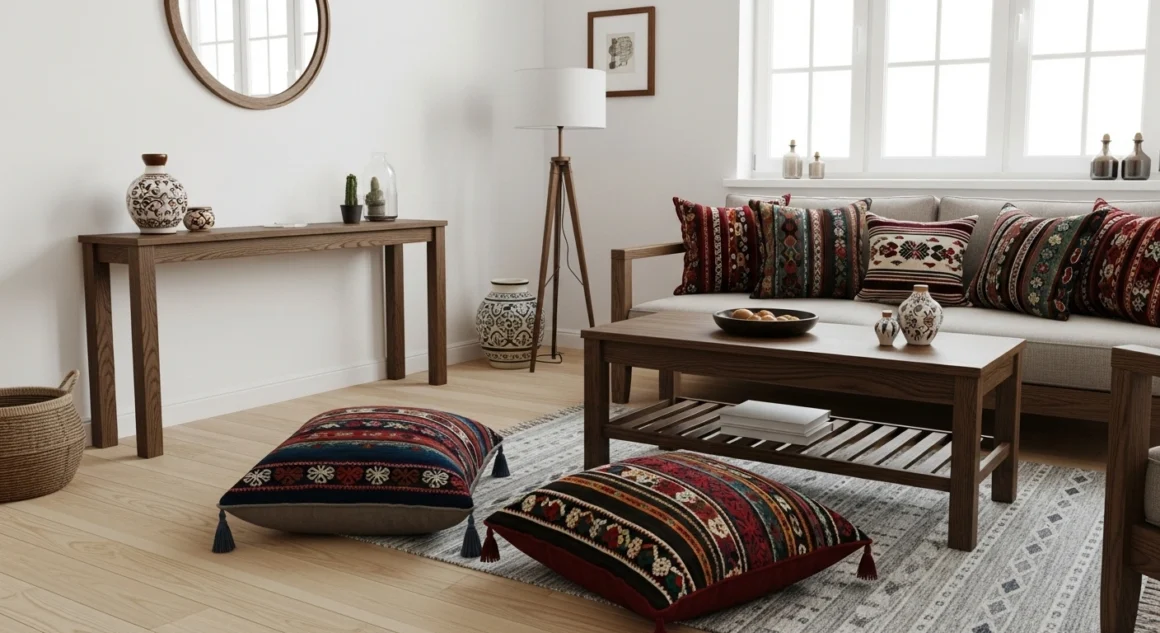
At first glance, Nordic and Balkan design might seem worlds apart.
Yet together, they create something truly captivating — a harmony between Scandinavian calm and Eastern European warmth.
This fusion preserves the simplicity of Nordic minimalism — clean lines, open spaces, and pale hues — but enriches it with the soul of Balkan craftsmanship.
Handwoven textiles, dark smoked woods, and folkloric patterns breathe warmth into cool, modern spaces.
Imagine a light-filled Swedish living room accented by a Serbian handwoven rug or a Bulgarian carved oak cabinet — design that tells a story, connecting simplicity with heritage.
The result is minimalism with emotion: calm, grounded, and deeply human.
Iberian-Moorish Modern — Warm Geometry and Contrast
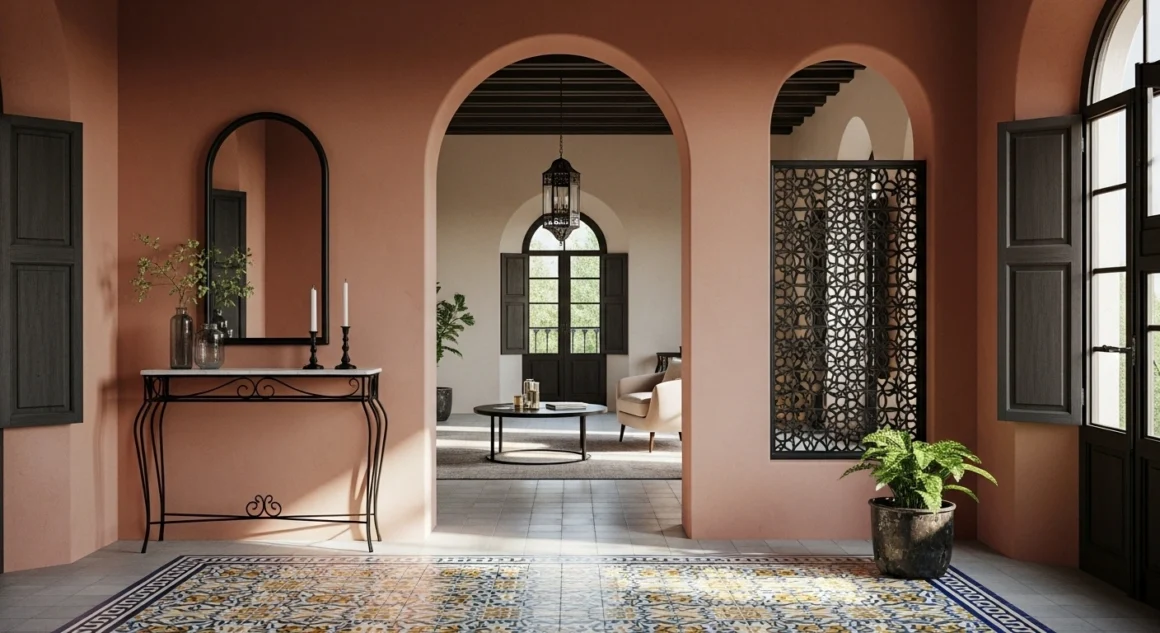
In the sun-drenched regions of Spain and Portugal, a new design language is emerging — Iberian-Moorish Modern.
It reinterprets centuries of shared history between Europe and North Africa, transforming traditional elements into modern expressions.
The hallmark of this style is geometry and warmth: reimagined azulejo tiles in abstract patterns, slender wrought-iron frames, and terracotta tones balanced with cool whites and blues.
Every detail carries memory — from Moroccan latticework to Andalusian arches — yet everything feels fresh and sophisticated.
This fusion brings back Mediterranean sensuality but within sleek, modern architecture — a perfect balance between heritage and modern minimalism.
Turkish-German Functionalism — Tradition Meets Precision
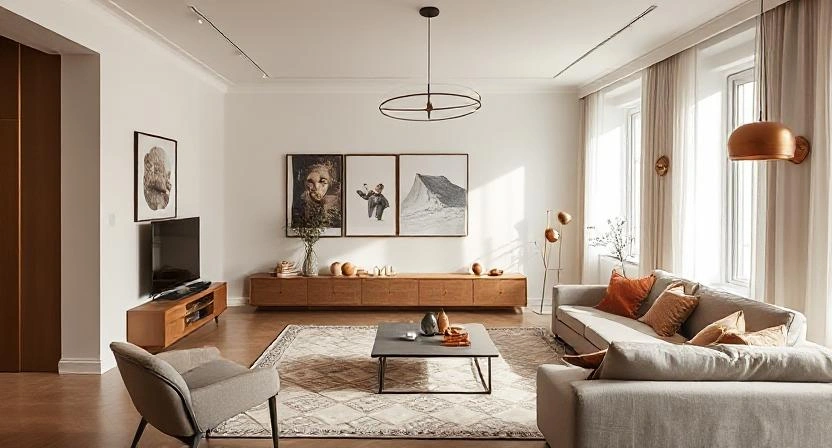
Germany’s design legacy is defined by order and function — think Bauhaus clarity and architectural precision.
But the country’s growing cultural mosaic has given rise to a new phenomenon: Turkish-German Functionalism.
Born from the creativity of second-generation Turkish immigrants, this fusion marries Ottoman artistry with German efficiency.
Intricate geometric motifs, warm copper accents, and subtle Islamic patterns find their place within linear, highly functional spaces.
Picture a modern Berlin apartment — minimal, structured, and efficient — softened by Anatolian textiles, warm lighting, and patterns echoing Istanbul’s mosques.
It’s a dialogue between heritage and modernity, where culture becomes an invisible yet powerful design layer.
Maghrebi-French Elegance — Paris Meets Marrakech
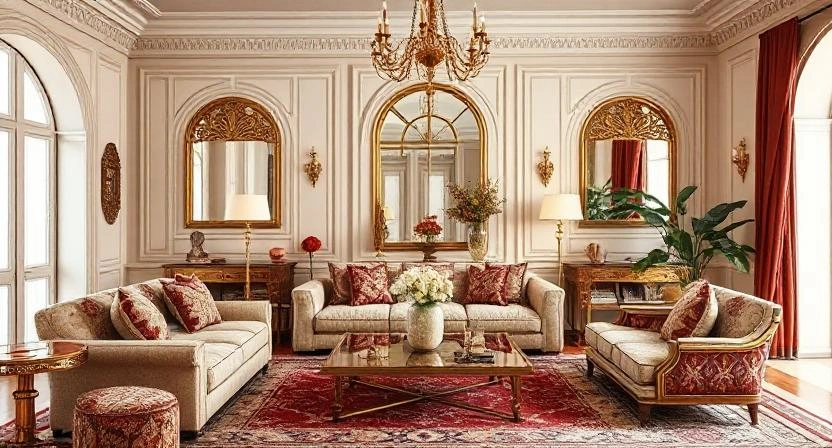
Few combinations feel as effortlessly luxurious as Maghrebi-French design.
It’s where Parisian refinement meets Moroccan soul — a graceful dance of structure and sensuality.
French design brings the architecture — the Haussmann moldings, the symmetry, the neutral palette.
The Maghrebi influence introduces color, rhythm, and ornamentation — intricate metalwork, embroidered fabrics, and geometric mosaics.
Together, they create spaces that are romantic yet vibrant, where every room feels like a journey from Paris to Marrakech.
This style has become a favorite among modern designers who seek to merge European sophistication with North African warmth — a celebration of contrast and connection.
Beyond Aesthetics — Ethics, Function, and Cultural Identity
Design in Europe has evolved beyond visual pleasure.
In 2025, interior design is no longer just about how a space looks — it’s about how people live, connect, and honor their roots.
Modern European homes are becoming reflections of ethical awareness, cultural empathy, and functionality designed for real life.
Cultural Impact on Space and Living
Mediterranean culture has always viewed the home as more than a private retreat — it’s a social space, a place for family gatherings, shared meals, and collective living.
This philosophy is now influencing design trends across all of Europe, reshaping how architects and interior designers think about modern homes.
In countries like Spain, Italy, and Greece, open-plan layouts continue to thrive — kitchens flow seamlessly into dining and living areas, allowing for conversation and connection.
But in Northern Europe, designers are now experimenting with multi-generational living, blending communal and private zones within one harmonious space.
Sliding partitions, layered lighting, and flexible furniture make it possible to switch between solitude and togetherness — reflecting Europe’s evolving family dynamics.
This cultural shift has made design more human: not just functional, but emotionally intelligent.
The Ethical and Sustainable Angle
As global design becomes more interconnected, a new question emerges:
How can we celebrate cultural heritage without reducing it to a trend?
Ethical design means giving credit and care to the origins of cultural elements — understanding their symbolism, craftsmanship, and value.
Across Europe, this has led to a revival of regional artisanal practices, reimagined for modern living:
- Murano glass from Italy now lights up contemporary spaces, its centuries-old craft transformed into sculptural modern lighting.
- Portuguese tile craft (azulejo) adds cultural texture to industrial lofts, blending history with raw architecture.
- Scottish tweed — once seen as purely traditional — is finding new life in minimalist interiors, offering warmth and tactility to sleek modern furniture.
This conscious design movement connects people to their cultural past while respecting sustainability and fair-trade values.
It’s no longer about borrowing aesthetics — it’s about continuing a story that has been passed down through generations.
The Digital Layer — How Technology Shapes Cultural Design
In the new era of design, technology isn’t replacing culture — it’s amplifying it.
Across Europe, architects and artists are using digital tools to preserve, reinterpret, and reimagine traditional aesthetics.
From immersive projections to AI-assisted craftsmanship, a new dialogue is emerging — one where heritage meets innovation.
The Virtual Heimat: Digital Heritage in Modern Spaces
The German word Heimat means “home” — not just a place, but a feeling of belonging.
In modern European interiors, this emotional sense of home is now being recreated through digital experiences.
Designers are using projection mapping and augmented reality (AR) to bring cultural motifs to life:
ancient patterns ripple across walls, folklore-inspired symbols glow softly in hallways, and digital murals change with the seasons.
At the same time, digital culture itself — from gaming visuals to pop art aesthetics — is reshaping how people choose color and form.
We see vibrant, pixel-inspired palettes, bold contrasts, and dynamic lighting inspired by virtual worlds.
This intersection between the physical and digital has made interiors more expressive, more interactive — and paradoxically, more human.
AI, 3D & Virtual Design Tools Preserving Tradition
Far from erasing craftsmanship, technology in Europe is helping revive it.
Artificial Intelligence, 3D modeling, and virtual design platforms are giving artisans new ways to protect and reinterpret traditional crafts.
- AI-assisted software analyzes historical patterns and materials, helping designers modernize ancient motifs while keeping their soul intact.
- 3D printing allows for precise reproduction of artisanal textures, from Baroque carvings to Moorish latticework, using sustainable materials.
- Virtual design environments let creators test cultural combinations safely, ensuring that inspiration doesn’t slip into appropriation.
These innovations don’t distance people from heritage — they deepen the connection.
Europe’s future of design is not a rejection of tradition but a digital evolution of it — one where art, culture, and technology work together to keep identity alive.
The Future of European Design — What Comes Next
The future of European design is neither purely traditional nor entirely futuristic — it’s something beautifully in between.
A growing movement known as “Hybrid Authenticity” is reshaping the continent’s creative landscape, blending technology with craftsmanship, innovation with memory, and local with global.
Designers are no longer asking how to preserve tradition, but how to extend it — how to translate centuries-old values into modern materials, digital platforms, and sustainable living.
In this new paradigm, design becomes much more than decoration; it becomes a language of cultural understanding.
A Mediterranean artisan working with 3D printing, or a Nordic architect collaborating with Moroccan ceramicists — these collaborations represent a new kind of creativity, one rooted in respect and exchange.
The next generation — Gen Z and young European immigrants — will take this even further.
They grew up in hybrid worlds: digital yet emotional, global yet deeply personal.
Their vision of home is fluid — a place where identity is expressed through color, texture, and story, not nationality or tradition alone.
As Europe continues to evolve through migration, cultural exchange, and digital innovation, its design will keep telling a story that’s both timeless and alive —
a story where every home, no matter where it stands, becomes a living symbol of connection, diversity, and authenticity.
Bringing Global Diversity into Your Own Home
Cultural fusion isn’t reserved for designers or large-scale projects — it can start right at home.
Blending styles from around the world allows you to tell your own story through design — a visual diary of places, memories, and values.
But balance is key: the goal is to create harmony, not chaos.
Here’s how to bring global influence into your home with taste, purpose, and authenticity.
How to Mix Cultural Styles Without Chaos
The secret to blending multiple design influences lies in proportion and intention.
Follow the timeless 60/30/10 rule:
- 60% base style (your dominant aesthetic — perhaps Scandinavian or Mediterranean),
- 30% complementary style (like Moroccan or Japanese),
- 10% accent pieces (art, textiles, or colors from another culture).
This formula creates a space that feels layered and personal, but never overwhelming.
Equally important is authenticity.
Instead of filling your home with commercial imitations, invest in original, handcrafted pieces that carry meaning — a handwoven Moroccan rug, an Italian Murano lamp, or a Japanese ceramic vase.
Each object becomes more than décor; it becomes a conversation piece, a fragment of the world that now lives in your home.
True beauty in design comes from respect — understanding the origins of what you use and letting each culture’s craftsmanship shine on its own terms.
Shopping the World Ethically
The modern homeowner has more access than ever to global design — but with that access comes responsibility.
Supporting ethical sources ensures that cultural appreciation never turns into exploitation.
Look for shops, cooperatives, or online marketplaces that champion Fair Trade principles and work directly with local artisans.
Not only does this sustain traditional crafts, but it also ensures fair pay and environmental respect.
When shopping online, explore curated collections from verified fair-trade platforms or independent designers who prioritize transparency.
You can also discover plenty of inspiration and practical ideas across our related guides:
- Boho Living Room — embracing eclectic global textures.
- Mediterranean Decor — warmth, natural materials, and timeless serenity.
- Modern Bedroom Ideas — blending comfort, minimalism, and personality.
Decorating globally doesn’t mean copying; it means celebrating — turning your home into a reflection of the world’s artistry, told through your unique lens.
Designer Spotlights — Voices of the New Europe
Behind every trend lies a story — and behind every design movement, a voice.
Across Europe, a new generation of designers is redefining what it means to create “European” interiors.
They are architects, artists, and craftspeople from diverse cultural backgrounds, each bringing a unique heritage into contemporary design.
These are the voices of the new Europe — a continent that no longer speaks with one aesthetic, but in a chorus of ideas and identities.
Selim Kaya — The Turkish-German Minimalist
Born in Berlin to Turkish parents, Selim blends German precision with Ottoman geometry.
His studio reimagines urban apartments with clean, functional layouts softened by handmade copper lamps, mosaic tiles, and natural textures.
For Selim, design is a language of harmony: “It’s about discipline meeting emotion — function meeting soul.”
Amira Benyoussef — The Parisian Moroccan Visionary
Amira, a Paris-based interior designer raised between Casablanca and Lyon, brings North African warmth into the structured world of French interiors.
Her projects balance Haussmannian elegance with Moroccan sensuality — embroidered fabrics, brass lanterns, and subtle desert tones.
She believes, “Luxury isn’t about perfection; it’s about emotion. Every material must carry a memory.”
Luka Petrovic — The Balkan Scandinavian Storyteller
Now based in Stockholm, Luka draws from his Serbian roots and Nordic surroundings to craft spaces that feel raw yet poetic.
He mixes Scandinavian restraint with Balkan storytelling — light oak floors, textured walls, and folkloric patterns reimagined in neutral palettes.
His mantra: “Minimalism doesn’t mean silence; it means listening closely to what truly matters.”
Together, these designers represent a new design philosophy — one that doesn’t erase origins but celebrates them.
Their work embodies the heart of modern Europe: collaborative, diverse, and beautifully human.
The Future of European Interiors — Designing for Connection, Not Just Style
The story of European interiors has always been about more than beauty — it’s about evolution, identity, and connection.
Today, that story continues to unfold in ways that reflect the continent’s growing cultural diversity and creative freedom.
Modern European design no longer divides itself by nationality — it thrives on collaboration, exchange, and emotion.
From a Parisian loft inspired by Moroccan craftsmanship to a Berlin apartment that echoes Turkish geometry, Europe’s homes are living testaments to cultural coexistence.
This new chapter in design is defined by connection: between people, between past and present, between technology and tradition.
Designers and homeowners alike are rediscovering that the most beautiful spaces are those that tell a story — one rooted in authenticity and shared humanity.
To design today is to connect.
To decorate is to remember.
And to create a home is to celebrate the diverse threads that make Europe — and the world — so endlessly inspiring.
FAQs — European Interior Design & Cultural Diversity
What is cultural diversity in interior design?
Cultural diversity in interior design refers to the blending of styles, materials, and traditions from different cultures to create spaces that feel inclusive and meaningful.
In Europe, it means celebrating the continent’s multicultural heritage — from Mediterranean warmth to Nordic minimalism — and reflecting it through color, texture, and craftsmanship.
How does globalization influence European design?
Globalization has made design more accessible and interconnected, but it has also blurred traditional boundaries.
In Europe, designers now mix local heritage with international ideas — a Spanish home might feature Japanese simplicity, while a Scandinavian apartment incorporates Moroccan textiles.
This exchange creates interiors that are both modern and rooted in cultural identity.
What are the most popular European fusion styles in 2025?
Some of the most influential fusion styles emerging in 2025 include:
- Nordic-Balkan Hybrid – minimalism infused with warmth and folklore.
- Iberian-Moorish Modern – Mediterranean geometry with North African accents.
- Turkish-German Functionalism – precision meets handcrafted heritage.
- Maghrebi-French Elegance – Parisian refinement with Moroccan color and texture.
These styles represent Europe’s new design language: diverse, emotional, and globally inspired.
How to apply these trends at home?
Start small and stay authentic.
Use the 60/30/10 rule to balance cultural influences — one dominant style, one secondary, and a few accent pieces.
Choose original handcrafted décor instead of mass-produced imitations, and shop ethically from artisans or fair-trade sources.
Above all, let your home tell your story — a reflection of the cultures, experiences, and values that shape who you are.

